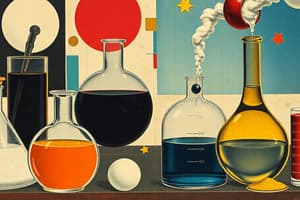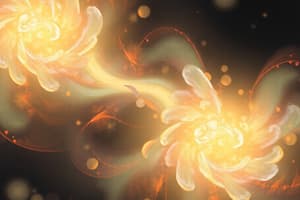Podcast
Questions and Answers
What are the characteristics of solids?
What are the characteristics of solids?
Solids have a fixed shape and volume, with molecules packed tightly together and vibrating in place.
How do liquids differ from solids?
How do liquids differ from solids?
Liquids flow and take the shape of their container, while still maintaining a constant volume.
Explain the behavior of gases in a container.
Explain the behavior of gases in a container.
Gases fill a container completely and expand to fill all available space.
How do the molecules in solids, liquids, and gases differ in terms of arrangement?
How do the molecules in solids, liquids, and gases differ in terms of arrangement?
What allows liquids to exert pressure on the walls of their container?
What allows liquids to exert pressure on the walls of their container?
What determines which state of matter a substance is in?
What determines which state of matter a substance is in?
Why does ice float on water?
Why does ice float on water?
What drives the conversions between states of matter?
What drives the conversions between states of matter?
How do substances change from solid to liquid or liquid to gas?
How do substances change from solid to liquid or liquid to gas?
How do substances change from gas to liquid or liquid to solid?
How do substances change from gas to liquid or liquid to solid?
Flashcards are hidden until you start studying
Study Notes
Exploring Matter in Our Surroundings: Understanding the States
Matter, the fundamental substance that makes up everything around us, can exist in different forms — states of matter. These states define how particles within matter behave and interact, leading to a diverse and fascinating world. In this article, we'll dive into the three primary states of matter and their characteristics.
- Solids
Solids are materials that have a fixed shape and volume, meaning their molecules are packed tightly together and vibrate in place. Examples include ice cubes, rocks, and metal bars. Solids have a definite shape, which means their molecules are arranged in a particular pattern. This organization makes solids strong, durable, and resistant to changes in shape. However, solids can still move, as the vibrations of their molecules create heat.
- Liquids
Liquids are materials that flow and take the shape of any container they are placed in, while still maintaining a constant volume. Examples include water, oil, and honey. Liquids consist of molecules held together by attractive forces but are not as tightly packed as solids. These forces allow the molecules to slide past one another, creating a smooth and continuous surface. However, liquids can also exert pressure on the walls of their container due to their cohesive nature.
- Gases
Gases are materials that fill a container completely, expanding to fill all available space. Examples include air, helium, and carbon dioxide. Gases consist of molecules that are very far apart and move freely around within their container. Gases have a very low density, which means they are lightweight and fill large volumes. Gases do not have a definite shape or volume, as their molecules can expand or contract according to changes in temperature and pressure.
Conversions between states of matter can occur through processes like vaporization (solid turning into gas), condensation (gas turning into liquid), freezing (liquid turning into solid), and melting (solid turning into liquid). These processes are driven by changes in temperature and pressure, or by adding or removing energy from the system.
Certain factors can determine which state of matter a substance is in. For example, the temperature and pressure of a substance will influence whether it is in a solid, liquid, or gas state. As temperature increases, a substance may change from solid to liquid or liquid to gas. Similarly, as pressure increases, a substance may change from gas to liquid or liquid to solid.
Understanding these states of matter helps us make sense of the world around us. For instance, we know that ice floats on water because it is less dense as a solid, while water is denser as a liquid. Also, we can predict how gases will expand and contract under different conditions, such as when a hot air balloon takes to the skies. By examining the behavior and characteristics of our surroundings at the molecular level, we can uncover the secrets of matter's diverse forms and properties.
Studying That Suits You
Use AI to generate personalized quizzes and flashcards to suit your learning preferences.




